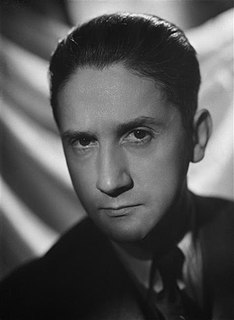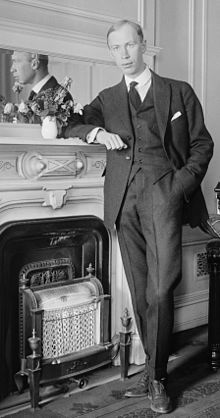
Sergei Sergeyevich Prokofiev was a Russian composer, pianist, and conductor who later worked in the Soviet Union. As the creator of acknowledged masterpieces across numerous music genres, he is regarded as one of the major composers of the 20th century. His works include such widely heard pieces as the March from The Love for Three Oranges, the suite Lieutenant Kijé, the ballet Romeo and Juliet—from which "Dance of the Knights" is taken—and Peter and the Wolf. Of the established forms and genres in which he worked, he created—excluding juvenilia—seven completed operas, seven symphonies, eight ballets, five piano concertos, two violin concertos, a cello concerto, a symphony-concerto for cello and orchestra, and nine completed piano sonatas.

Sergei Pavlovich Diaghilev, usually referred to outside Russia as Serge Diaghilev, was a Russian art critic, patron, ballet impresario and founder of the Ballets Russes, from which many famous dancers and choreographers would arise.

Roger Désormière was a French conductor. He was an enthusiastic champion of contemporary composers, but also conducted performances of early eighteenth century French music.

Isao Tomita, often known simply as Tomita, was a Japanese composer, regarded as one of the pioneers of electronic music and space music, and as one of the most famous producers of analog synthesizer arrangements. In addition to creating note-by-note realizations, Tomita made extensive use of the sound-design capabilities of his instrument, using synthesizers to create new sounds to accompany and enhance his electronic realizations of acoustic instruments. He also made effective use of analog music sequencers and the Mellotron, and featured futuristic science-fiction themes, while laying the foundations for synth-pop music and trance-like rhythms. Many of his albums are electronic versions and adaptations of familiar classical music pieces. He received four Grammy Award nominations for his 1974 album based on music by Claude Debussy, Snowflakes Are Dancing.

Sergei Alexandrovich Koussevitzky was a Russian-born conductor, composer and double-bassist, known for his long tenure as music director of the Boston Symphony Orchestra from 1924 to 1949.

Symphony No. 4, Op. 47 (112), is actually two works by Sergei Prokofiev. The first, Op. 47, was written in 1929 and premiered in 1930; it lasts about 22 minutes. The second, Op. 112, is a large-scale revision and lengthening from 1947; it lasts about 37 minutes. Both use musical material originally written for Prokofiev's ballet The Prodigal Son. The two works are stylistically different, reflecting their respective compositional contexts. They are formally different too: the instrumentation and scope of the revision is larger.

The Firebird is a ballet and orchestral concert work by the Russian composer Igor Stravinsky. It was written for the 1910 Paris season of Sergei Diaghilev's Ballets Russes company; the original choreography was by Michel Fokine, who collaborated with Alexandre Benois on a scenario based on the Russian fairy tales of the Firebird and the blessing and curse it possesses for its owner. It was first performed at the Opéra de Paris on 25 June 1910 and was an immediate success, catapulting Stravinsky to international fame. Although designed as a work for the stage, with specific passages accompanying characters and action, the music achieved equal if not greater recognition as a concert piece.

Romeo and Juliet, Op. 64, is a ballet by Sergei Prokofiev based on William Shakespeare's play Romeo and Juliet. First composed in 1935, it was substantially revised for its Soviet premiere in early 1940. Prokofiev reused music from the ballet in three suites for orchestra and a solo piano work.
Sergei Prokofiev began his Violin Concerto No. 1 in D major, Op. 19, as a concertino in 1915 but soon abandoned it to work on his opera The Gambler. He returned to the concerto in the summer of 1917. It premiered on October 18, 1923 at the Paris Opera with Marcel Darrieux playing the violin part and the Paris Opera Orchestra conducted by Serge Koussevitzky. Igor Stravinsky made his debut as conductor at the same concert, conducting the first performance of his own Octet for Wind Instruments.

The Ballets Russes was an itinerant ballet company begun in Paris that performed between 1909 and 1929 throughout Europe and on tours to North and South America. The company never performed in Russia, where the Revolution disrupted society. After its initial Paris season, the company had no formal ties there.
On the Dnieper, Op. 51, also known by its French language title Sur le Borysthène, composed in 1932, is the fourth ballet composed by Sergei Prokofiev. He was commissioned to compose this work by the Ballet de l'Opéra National de Paris after the unexpected death of Ballets Russes choreographer Sergei Diaghilev in 1929 and following on the heels of Prokofiev's successful score for The Prodigal Son.

Sergei Prokofiev's Lieutenant Kijé music was originally written to accompany the film of the same name, produced by the Belgoskino film studios in Leningrad in 1933–34 and released in March 1934. It was Prokofiev's first attempt at film music, and his first commission.

Chout, Op. 21, is the usual English-language title of a ballet by Sergei Prokofiev, written in two versions between 1915 and 1921. It is sometimes known as "The Tale of the Buffoon", or simply "The Buffoon". There also exists a symphonic suite from the ballet, Op. 21 bis, which is much more often performed than the full ballet score.

Le pas d'acier, Op. 41, is a 1926 ballet in two scenes containing eleven dances composed by Sergei Prokofiev. Prokofiev also created a four-movement orchestral suite from the ballet.
Leonid Leonidovich Sabaneyev or Sabaneyeff or Sabaneev was a Russian musicologist, music critic, composer and scientist. He was the son of Leonid Pavlovich Sabaneyev, a famous hunting expert, and his brother Boris was also a musician.
Yuri Fyodorovich Fayer, was a Soviet Jewish conductor, highly notable in ballet. He was the chief ballet conductor at the Bolshoi Theatre from 1923 to 1963.
Christopher Francis Palmer was an English composer, arranger and orchestrator; biographer of composers, champion of lesser-known composers and writer on film music and other musical subjects; record producer; and lecturer. He was involved in a very wide range of projects and his output was prodigious. He came to be regarded as one of the finest symphonic orchestrators of his generation. He was dedicated to the conservation, recording and promotion of classic film scores by composers such as Bernard Herrmann, Dimitri Tiomkin, Franz Waxman, Miklós Rózsa, Elmer Bernstein and others. He wrote full biographies as well as sleeve notes, radio scripts, reviews and articles, on composers such as Benjamin Britten, Frederick Delius, Karol Szymanowski, Arthur Bliss, George Dyson, Herbert Howells, Maurice Ravel, Nikolai Tcherepnin and others.
Tales of an Old Grandmother, Op. 31 is a set of four piano pieces by Sergei Prokofiev. It was composed in 1918 and premiered by the composer himself on January 7 the following year in New York City, probably at Aeolian Hall. It has an approximate duration of ten minutes and it was first published by Gutheil in Moscow in 1922. It was composed during Prokofiev's exile in the United States after the outbreak of the Russian Revolution. An arrangement for orchestra also exists.

Russian Overture, Op. 72, is an overture composed in 1936 by Sergei Prokofiev.













